Blog Log! February 17, 2008!
 February 19, 2008
February 19, 2008
 If you read our Blog Log last month, you might’ve gasped at the report of us having to “dodge the currents” because they were so strong. Well, this time around, we weren’t quite so lucky as to be able to dodge them! The currents created little whirl pools on the waters surface, giving divers a good Sunday morning workout trying to beat the current! But it all ended well, with the spectacle that is Hantu shining through despite the less than favourable water conditions! “At least the weather was good!” we all consoled ourselves! And the 27 degC waters (water temperatures have been observed to drop during the turn on the monsoon seasons) left all of us nicely chilled despite the intense sunshine. This post features pictures taken both by myself and long-time, super experienced, critter hunter, reef walker, and Hantu diver, Chay Hoon!
If you read our Blog Log last month, you might’ve gasped at the report of us having to “dodge the currents” because they were so strong. Well, this time around, we weren’t quite so lucky as to be able to dodge them! The currents created little whirl pools on the waters surface, giving divers a good Sunday morning workout trying to beat the current! But it all ended well, with the spectacle that is Hantu shining through despite the less than favourable water conditions! “At least the weather was good!” we all consoled ourselves! And the 27 degC waters (water temperatures have been observed to drop during the turn on the monsoon seasons) left all of us nicely chilled despite the intense sunshine. This post features pictures taken both by myself and long-time, super experienced, critter hunter, reef walker, and Hantu diver, Chay Hoon!
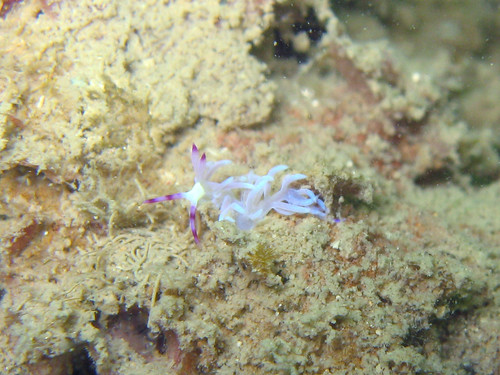 We had quite a cosmopolitan weekend with divers joining us from origins of France, Australia, and Indonesia. Beneath the waters surface, life was as if not even more diverse! Flabellina’s were out in full force! With large ones and even tiny ones braving the currents as they creep along the reefs in search of a mate or a meal!
We had quite a cosmopolitan weekend with divers joining us from origins of France, Australia, and Indonesia. Beneath the waters surface, life was as if not even more diverse! Flabellina’s were out in full force! With large ones and even tiny ones braving the currents as they creep along the reefs in search of a mate or a meal!
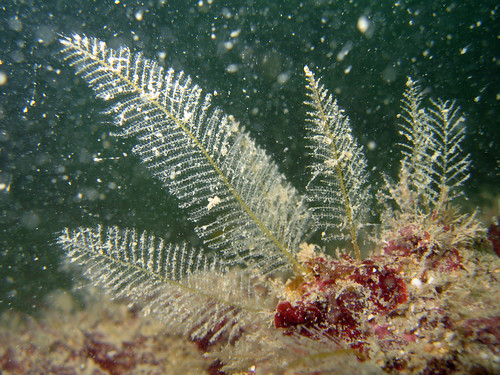 As we stuck really close to the reef, there were somethings that we kept ourselves well aware of (and away from)! Such as the stinging menace that hydriods are. Like corals, hydriods are a colony of animals living together. They are from the family cnidaria. Although they are infamous for the wave after wave of pain the can incur for the careless diver, they are actually very pretty animals. They occur in an array of colours from white and yellow, to red and black, resembling a feather of a bird or a frond of a fern.
As we stuck really close to the reef, there were somethings that we kept ourselves well aware of (and away from)! Such as the stinging menace that hydriods are. Like corals, hydriods are a colony of animals living together. They are from the family cnidaria. Although they are infamous for the wave after wave of pain the can incur for the careless diver, they are actually very pretty animals. They occur in an array of colours from white and yellow, to red and black, resembling a feather of a bird or a frond of a fern.
 Other details that we caught notice of were the intricate patterns of corals such as this Diploastrea and the tentacles of a palm-sized mushroom coral. The latter is a free living coral, capable of moving itself across the reef. Hantu Blog reefguide Mingsheng enlightened me once that mushroom corals achieve this by infusing themselves with waters, making themselves less dense. Doing this allows them to “float” and skim across the reef. This trait is possibly one of the reasons why mushroom corals are so hardy, being able to relocate themselves to greener pastures when the going gets tough! They also have the largest coral polyp amongst all corals, and unlike other corals, do not live in colonies but occur singly.
Other details that we caught notice of were the intricate patterns of corals such as this Diploastrea and the tentacles of a palm-sized mushroom coral. The latter is a free living coral, capable of moving itself across the reef. Hantu Blog reefguide Mingsheng enlightened me once that mushroom corals achieve this by infusing themselves with waters, making themselves less dense. Doing this allows them to “float” and skim across the reef. This trait is possibly one of the reasons why mushroom corals are so hardy, being able to relocate themselves to greener pastures when the going gets tough! They also have the largest coral polyp amongst all corals, and unlike other corals, do not live in colonies but occur singly.
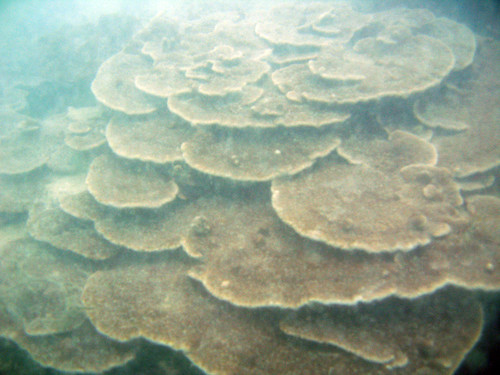 Here’s a look at a truly LARGE Serpent coral colony. This one has a diameter that is about twice my height! Incredible if you wonder how old it possibly is, considering these animals grow so slowly. The curves and edges of the coral as it grows is reminiscent of cloud forms in period Chinese and Japanese art!
Here’s a look at a truly LARGE Serpent coral colony. This one has a diameter that is about twice my height! Incredible if you wonder how old it possibly is, considering these animals grow so slowly. The curves and edges of the coral as it grows is reminiscent of cloud forms in period Chinese and Japanese art!
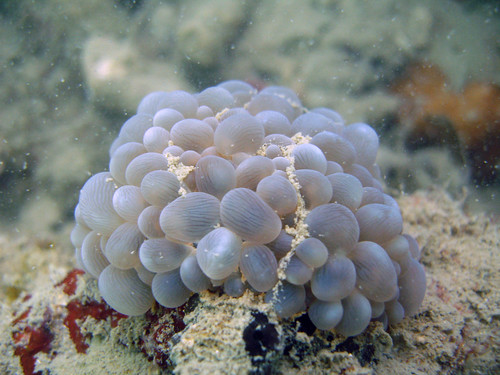 Recruits! This round bubble coral colony is one of the many tiny colonies of corals we saw today, that may one day grow to be as large as the resilient serpent coral colony!
Recruits! This round bubble coral colony is one of the many tiny colonies of corals we saw today, that may one day grow to be as large as the resilient serpent coral colony!
Then there are the sponges, which when they get to a good size can be very intriguing to look at. This is a pink variation of Spiky Sponge. Sponges consist of a mass of cells supported by fibres or by spicules made of silica. The polyps are known to be able to recolonise if separated by squeezing them through a wire mesh and contained in a fixed body of water.
 There were also plenty of swimmer crabs!
There were also plenty of swimmer crabs!
 And Chay Hoon’s favourite – nudibranchs! She even added a new one to her record today! A new record for Chay Hoon is a new record for all of us!
And Chay Hoon’s favourite – nudibranchs! She even added a new one to her record today! A new record for Chay Hoon is a new record for all of us!
 And of course, everyones perennial favourite – the seahorse. We love our seahorses. They are ambassadors of Hantu’s reef, and represent the elusive, exotic and enticing nature of our reef and all the fauna that is contained within it! You haven’t quite visited Hantu if you haven’t met one of our seahorses!
And of course, everyones perennial favourite – the seahorse. We love our seahorses. They are ambassadors of Hantu’s reef, and represent the elusive, exotic and enticing nature of our reef and all the fauna that is contained within it! You haven’t quite visited Hantu if you haven’t met one of our seahorses!
For more pictures from the dive, check out the Hantu Blog Gallery!
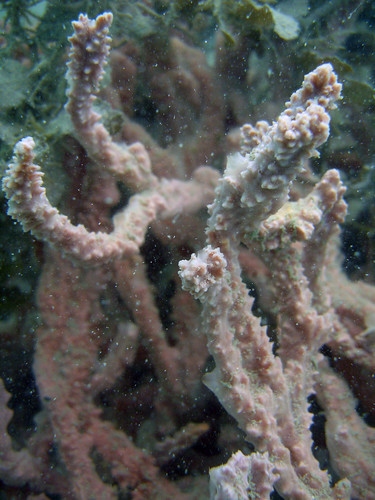
 Posted in
Posted in 



 content rss
content rss
COMMENTS